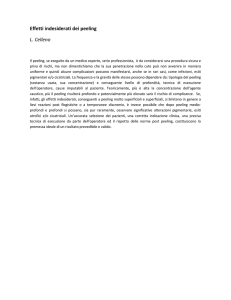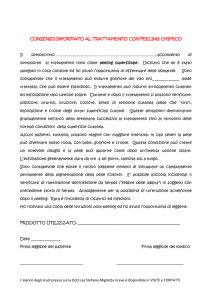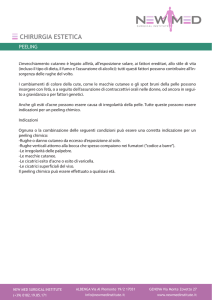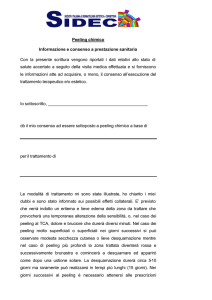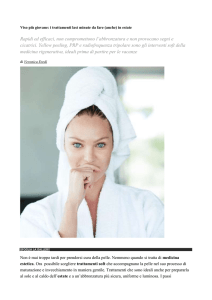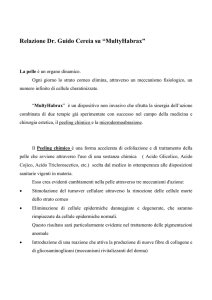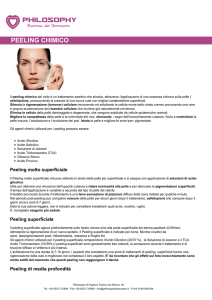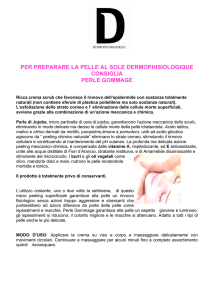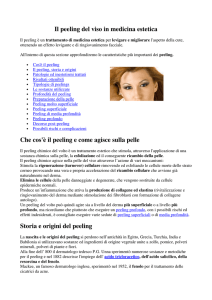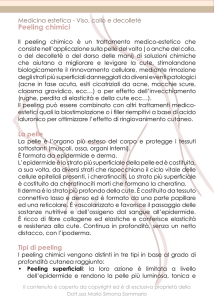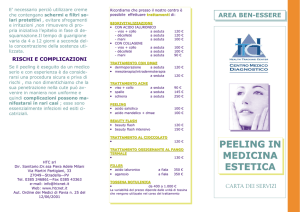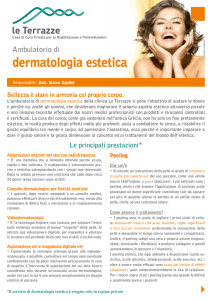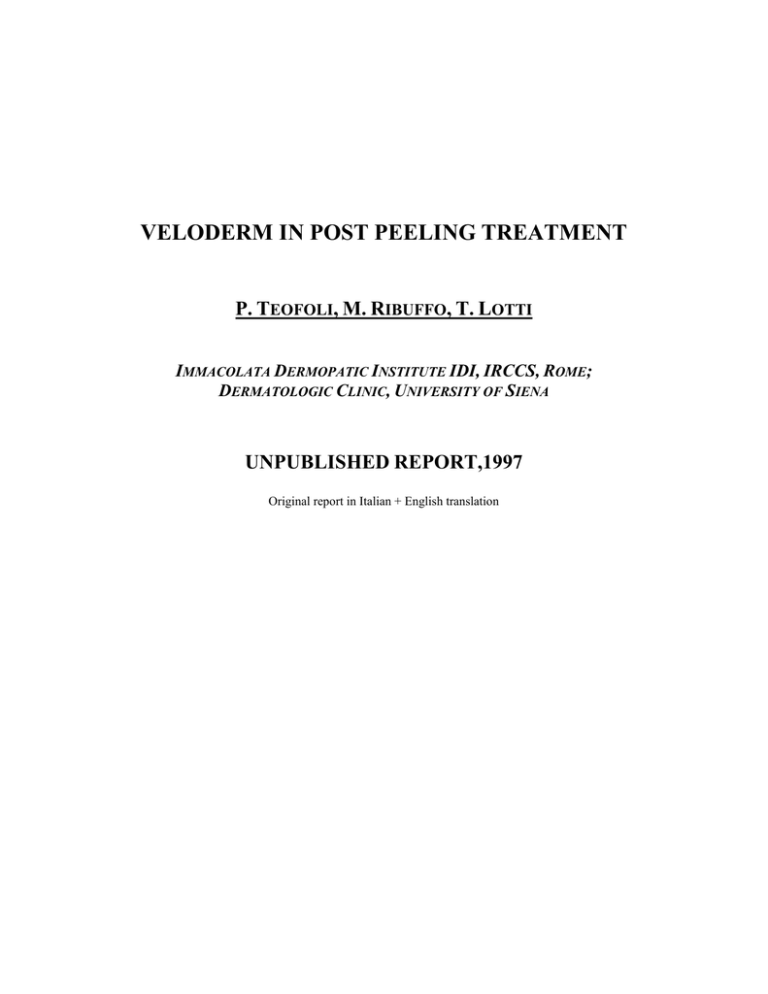
VELODERM IN POST PEELING TREATMENT
P. TEOFOLI, M. RIBUFFO, T. LOTTI
IMMACOLATA DERMOPATIC INSTITUTE IDI, IRCCS, ROME;
DERMATOLOGIC CLINIC, UNIVERSITY OF SIENA
UNPUBLISHED REPORT,1997
Original report in Italian + English translation
IMPIEGO DI VELODERM PER IL TRATTAMENTO DI AREE SOTTOPOSTE A PEELING
CHIMICO CON TCA IN PAZIENTI AFFETTI DA ESITI CICATRIZIALI POSTACNEICI.
P. TEOFOLI, M. RIBUFFO, T. LOTTI
Istituto Dermopatico della Immacolata - IDI, IRCCS, Roma
Clinica Dermatologica Università di Siena
Introduzione
Il peeling chimico consiste nell’applicazione di una o più sostanze esfolianti sulla cute con
conseguente distruzione e successiva riparazione e rigenerazione di porzioni dell’epidermide e/o del
derma, finalizzate alla risoluzione o al miglioramento di inestesismi cutanei quali quelli collegati al
fotoinvecchiamento, le cheratosi attiniche, il cloasma, le lentigo senili, le cicatrici postacneiche.
Il peeling chimico permetterebbe una fase di riparazione tissutale controllata, caratterizzata da una
stimolazione della crescita epidermica attraverso la rimozione dello stato corneo con distruzione
specifica degli strati cutanei danneggiati e conseguente rigenerazione tissutale, induzione di una
reazione infiammatoria più profonda nel tessuto e rilascio di citochine e fattori di crescita favorenti le
neosintesi di matrice extracellulare.
I peeling chimici si distinguono in superficiali, medi e profondi a seconda del livello di profondità a
cui possono indurre esfolazione solitamente dipendente dalla concentrazione della sostanza esfoliante
utilizzata e dalla durata di applicazione (1).
Il peeling con acido tricloroacetico (TCA) è sicuramente quello più efficace per il trattamento di esiti
cicatriziali post-acneici e di rughe. Il paziente nei giorni successivi al peeling presenta una reazione
assimilabile ad una ustione di 1° grado caratterizzata da una esfoliazione che dura circa 8 – 10 giorni,
in cui è prevista l’applicazione di creme antibiotiche e l’assoluta protezione dalla radiazione
ultravioletta.
VELODERM è una pellicola trasparente a base di emicellulosa naturale, la cui applicazione crea un
ambiente ideale per la guarigione del tessuto cutaneo ove consente di ripristinare, almeno
temporaneamente, le funzioni di protezione e barriera.
La pellicola è una membrana trasparente che permette di osservare l’andamento della guarigione.
L’applicazione di VELODERM fa si che il tessuto danneggiato si mantenga ad una temperatura ideale
e ad un’adeguata umidità, favorendo anche la diminuzione del dolore.
VELODERM è permeabile all’ossigeno ed al tempo stesso funge da barriera verso l’esterno,
impedendo la penetrazione di microrganismi, polvere ed altri materiali potenzialmente dannosi per la
corretta riparazione tissutale.
In questo studio aperto è stata valutata l’efficacia, la tollerabilità e l’accettabilità cosmetica
dell’applicazione di VELODERM nei giorni successivi al peeling chimico con TCA, in pazienti affetti
da esiti cicatriziali post-acneici.
Pazienti e Metodi
Lo studio è stato eseguito, dopo consenso verbale, su un gruppo di 30 pazienti (18 di sesso
femminile e 12 di sesso maschile, di età compresa tra 19 e 35 anni), affetti da cicatrici depresse di
grado moderato del volto, esito di precedente processo infiammatorio acneico.
Un gruppo di controllo di 12 pazienti è stato trattato con “post-peeling care” tradizionale, senza uso di
VELODERM.
I pazienti sono stati sottoposti a peeling chimico di media profondità con TCA in soluzione acquosa al
33%. Al “post - peeling care” i pazienti sono stati istruiti all’applicazione giornaliera di VELODERM
ogni sera per una settimana. Al mattino la pellicola veniva rimossa con impacco di acqua borica al 3%.
I pazienti sono stati sottoposti a visita di controllo dopo 10 e dopo 14 giorni dall’esecuzione del peeling
chimico. E’ stato consigliato di applicare creme solari così dette “a spettro totale” (schermo solare
assoluto) prima di uscire all’aperto.
Risultati
Le valutazioni cliniche hanno evidenziato, al termine del trattamento, un’ottima accttabilità
cosmetica del VELODERM e assenza di sintomi cutanei oggettivi e soggettivi non previsti dal peeling
stesso.
I pazienti hanno riferito, dopo l’applicazione del VELODERM, un miglioramento della sintomatologia
soggettiva (bruciore) presente nei primi 2 giorni successivi al trattamento esfoliante e miglioramento
della secchezza cutanea con effetto che potremmo definire lenitivo ed emolliente.
Alla prima visita di controllo 24 pazienti presentavano una quasi totale esfoliazione con minimi di
diverso grado del quadro clinico cicatriziale, con assenza completa di esfoliazione residua.
Rispetto ai pazienti di controllo che non avevano applicato VELODERM, i sintomi soggettivi riferiti
dai pazienti sembravano indicare un chiaro effetto lenitivo della medicazione VELODERM.
Oggettivamente i pazienti che avevano applicato VELODERM mostravano un minor grado di eritema
ed una riduzione del tempo di esfoliazione rispetto ai soggetti al controllo trattati con “post-peeling
care” tradizionale.
Conclusioni
L’applicazione di VELODERM nella settimana successive all’esecuzione di peeling chimico con TCA
determina:
-
una riduzione della sintomatologia soggettiva di bruciore e talora iperestesia riferiti dal paziente
riduzione del tempo di esfoliazione
riduzione significativa dell’eritema e del rischio di pigmentazione post-infiammatoria
conseguente al peeling chimico stesso
VELODERM ha determinato un miglioramento della capacità riparativa tissutale con riduzione dei
tempi di riparazione. Il prodotto è stato inoltre ben tollerato e ben accettato.
Riteniamo pertanto che VELODERM risulti indicato nel trattamento post-peeling per la ottimizzazione
dei processi flogistici e riparativi tessutali indotti dal trattamento peeling.
BIBLIOGRAPHY
1) Garsetich I. Teofoli P. Gantheva M. Ribuffo M. Puddu P.: Chemical peeling.
When, how, why, J. Eur Acad Dermatol Venereol January 1997, 8:1-11
2) Lotti T-Gasperini S. Rodofili C. Should we use occlusive dressing in treating acute wounds? Int. J.
Dermatol, 1977, in press
-ENGLISH TRANSLATIONVELODERM IN POST PEELING TREATMENT.
P. TEOFOLI, M. RIBUFFO, T. LOTTI
Immacolata Dermopatic Institute IDI, IRCCS, Rome
Dermatologic Clinic, Siena University of Studies
Introduction
The chemical peeling consists on the use of one or more defoliating substances on the skin, with
subsequent destruction, repair and regeneration of portions of epidermis and/or derma. Such are to
solve cutaneous blemish, like those related to aging, actinic cheratosis, cloasma, senile lentigo, postacne scars. The chemical peeling would allow a controlled tissue repair characterized by a stimulation
of the epidermis growth through the removal of the corneous layer with specific destruction of the
damaged cutaneous layers and consequent tissue regeneration, induction of a deeper inflammatory
reaction in the tissue and release of cytokines and growth factors that favours the neo-synthesis of extra
cellular matrix.
Chemical peelings can be divided in superficial, mediums and profound, according to the depth of the
induced defoliation that is usually determined by the concentration of the defoliating substance used, or
by the application lenght(1).
The peeling with acid tricloroacetic acid (TCA) is certainly the most efficient one for the treatment of
superficial post-acne outcomes and wrinkle. In the post-peeling days the patients show a reaction
similar to a 1st degree burn, characterized by a defoliation lasting 8-10 days, usually treated by
application of antibiotic cream and by total protection from ultra-violet radiation.
Veloderm is a transparent film based on natural hemicellulose and its application creates an ideal
microenvironment for the recovery of cutaneous tissue: it temporarily restores the functions of
protection and barrier. The film is a transparent membrane that allows to monitor the healing process.
The use of Veloderm maintains an ideal temperature and suitable humidity for the wounds, favouring
also the pain reduction. Veloderm is permeable to the oxygen and at the same time works as a barrier
preventing the penetration of microorganisms, dust and other potentially damaging materials.
In this open study it was evaluated the efficiency, tolerability and cosmetic acceptability of Veloderm
application in the days following a chemical peeling with TCA in patients affected by post-acne
outcomes.
Patients and Methods
The study has been carried out, after verbal informed consent, in a group of 30 patients (18 female and
12 male, aged between 19 and 35), affected by moderated degree depressed scars on the face caused by
a acne-inflammatory process. The patients have been submitted to chemical peeling of medium depth
with TCA in aqueous solution at 33%. A group of control of 12 patients has been treated with
traditional "post peeling care" without the use of Veloderm. The other group of patients had been
instructed to the daily application of Veloderm every night for a week for the "post peeling care".
Every morning the film was removed with boric water compress at 3%. The patients were submitted to
a check visit after 10 and after 14 days from the chemical peeling. They were advised to apply solar
cream all over the area (total solar shield) before sun exposure.
Results
The clinical evaluations showed, at the end of the treatment, a good cosmetic acceptance of Veloderm
and absence of objective and subjective cutaneous symptoms unexpected and not related to the peeling
in itself. The patients reported (after the use of Veloderm) an improvement of the subjective
symptomathology (burning reduction) in the first two days following the defoliating treatment and also
improvement of cutaneous dryness by an effects that we can define as soothing and softening. In the
first check visit 24 patients showed almost total defoliation with minimums of several degrees of the
healing clinic situation with total absence of residual defoliation. In comparison to the patient treated in
a traditional way, the subjective symptoms reported by the patients treated with Veloderm seemed to
indicate a clear calming effect of the Veloderm medication. Objectively the patients treated with
Veloderm showed a lower degree of erythema and a reduction in the defoliation time in opposition to
those submitted to check and treated with traditional "post peeling care".
Conclusions
The application of Veloderm in the week following the execution of TCA chemical peeling determines:
- reduction of subjective symptomathology of burning and sometimes hyperaesthesia reported by the
patient;
- reduction in the time of defoliation;
- significantly reduction of the erythema and of the risk of post-inflammatory pigmentation following
the chemical peeling.
Veloderm determined an improvement of the tissue repairing capacity with reduction of the repairing
time. The product has been well tolerated and accepted.
Therefore we consider that Veloderm can be indicated for post peeling treatment in the improvement of
the tissue-repairing process.
BIBLIOGRAPHY
1) Garsetich I. Teofoli P. Gantheva M. Ribuffo M. Puddu P.: Chemical peeling.
When, how, why, J. Eur Acad Dermatol Venereol January 1997, 8:1-11
2) Lotti T-Gasperini S. Rodofili C. Should we use occlusive dressing in treating acute wounds? Int. J.
Dermatol, 1977, in press

